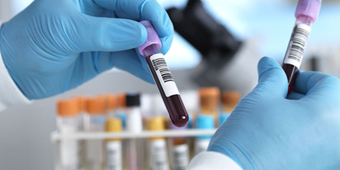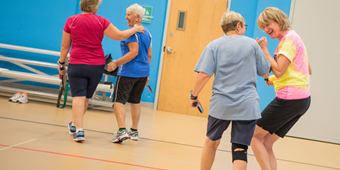Tips to Live Well (and Safely) with Blood Thinners

Answer a few questions and we'll provide you with a list of primary care providers that best fit your needs.
Are you or a loved one among the two to three million Americans taking blood-thinning medications (also called anticoagulants)? These lifesaving drugs prevent blood clots from forming, growing or moving to critical areas in your body that could block blood flow.
If your body is at risk for forming a blood clot that could lead to stroke or a heart attack, your doctor may prescribe a blood thinner. People with atrial fibrillation often need these. Atrial fibrillation, a common irregular heartbeat often call A-Fib, is a leading risk factor for stroke. It can cause blood to collect in the heart and potentially form a clot, which can travel to the brain and cause a stroke.
People with carotid artery disease also often are prescribed blood thinners. The carotid arteries in your neck carry blood to the head and brain. If a carotid artery becomes blocked by a clot, a stroke occurs. Blood-thinning medicines also are recommended for people who have had a stroke or heart attack or who have heart rhythm or heart valve problems.
Anticoagulant drugs come in pill form or sometimes injections. Common types are:
- Aspirin
- Heparin (Hemochron, Hep-Lock)
- Warfarin (Coumadin)
- Clopidogrel bisulfate (Plavix)
- Dabigatran (Pradaxa)
- Rivaroxaban (Xarelto)
- Apixaban (Eliquis)
- Edoxaban (Savaysa).
Your doctor will help decide if you need an anticoagulant and which blood thinner is right for you.
Be on the Alert for Bleeding
The lifesaving potential of blood thinners must be balanced with the risk of their biggest side effect: internal or external bleeding. If you cut yourself while shaving, get a cut on your finger from a kitchen knife or gardening tool, or fall and bump your head, the blood thinner slows your body’s ability to clot and stop bleeding at a normal rate. Nosebleeds also are more common for people who take blood thinners. Many times, this is more of an annoyance than a threat to your safety.
Even though these minor bleeds may be a nuisance, it is extremely important to continue taking your medicine as directed by your physician. The blood thinner is protecting you from developing dangerous or life-threatening blood clots.
If you have a more serious bleed — perhaps a significant fall or injury that could cause internal bleeding in the head or stomach — you should call your doctor or seek medical attention immediately. Warning signs of abnormal bleeding include:
- Bleeding that doesn’t stop in 10 minutes
- Coughing or throwing up blood
- Dark-colored urine or black stools
- Bloody diarrhea or bleeding hemorrhoids
- Severe pain in your head or abdomen
- Unexplained bleeding from the gums and nose
- Bruising with no apparent cause
- A heavier-than-normal menstrual period or bleeding between periods
- Red or black-and-blue marks on your skin that get larger
- Dizziness or fatigue
- Chest pain or trouble breathing
- Allergic reactions such as rash, itching or swelling
The lifesaving potential of blood thinners must be balanced with the risk of their biggest side effect: internal or external bleeding.
Take Common-sense Precautions
You can still do most activities you enjoy while you’re taking blood thinners. Consider taking some common-sense precautions, however:
- Avoid high-risk sports that expose you to cuts, scrapes and excessive bruising.
- If you do sports activities, wear protective gear, such as a bicycle helmet or protective pads for knees and elbows.
- Wear gloves while working in the yard.
- Trim fingernails and toenails carefully.
- Use a soft toothbrush and wax-coated floss.
- Avoid going barefoot or trimming calluses or corns on your feet.
- Use an electric razor rather than a razor blade.
If you have a minor bleed, there are several over-the-counter products to help stop bleeding. Special bandages, wound dressings, powders and gels are available at most pharmacies or online.
Follow Safe Practices
Getting the right dosage of a blood thinner is extremely important. Too much puts you at risk for bleeding and too little puts you at risk for stroke. If you are taking an anticoagulant, follow these guidelines:
- Tell anyone who is providing medical or dental care for you that you’re taking a blood thinner.
- Carry an ID card or wear a medical-alert bracelet that says you take an anticoagulant.
And if that anticoagulant is warfarin:
- Closely follow your doctor’s recommendations for regular lab testing while taking warfarin, to ensure that you are taking the best, most effective dosage for you.
- Eat a consistent diet, with consistent amounts of vitamin K. Vitamin K helps your blood clot and could affect how warfarin works. Talk to your doctor before making significant changes in your diet.
Tell your doctor about all medicines you take to help avoid interactions. This includes over-the-counter medicines, supplements or herbal remedies. Do not start taking any new medicines unless you check with your doctor first.
Common medications that interfere with the work of anticoagulants include:
- Antibiotics
- Heart medicines
- Cimetidine (treats excess stomach acid and peptic ulcers)
- Aspirin or other anti-inflammatory drugs such as ibuprofen, naproxen, ketoprofen or other arthritis medicines
- Drugs for depression, cancer, HIV (protease inhibitors), diabetes, seizures, gout, high cholesterol or thyroid replacement
- Vitamins containing vitamin K or herbal products such as ginkgo, Co-Q10, garlic or St. John's wort
Answer a few questions and we'll provide you with a list of primary care providers that best fit your needs.
Source: American Heart Association; National Blood Clot Alliance; National Heart, Lung, and Blood Institute




